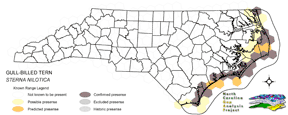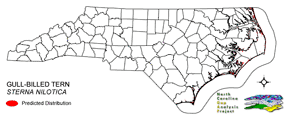
| Taxa: |
| Order: |
| Family: |
| Aves |
| Charadriiformes |
| Laridae |
| NatureServe Global Rank: |
| NatureServe State (NC) Rank: |
| G5 |
| S3B,SZN |
| Federal Status: |
| NC State Status: |
| --- |
| T |


| Land Unit |
| US Fish & Wildlife Service |
| US Forest Service |
| US National Park Service |
| US Department of Defense |
| NC State Parks |
| NC University System |
| NC Wildlife Res. Com. |
| NC Forest Service |
| NC Div. of Coastal Mgmt. |
| Local Governments |
| Non-Governmental Org. |
| Other Public Lands |
| Private Lands |
| GAP Status 1-2 |
| All Protected Lands |
| Statewide |
| Hectares |
| 13,815.63 |
| 146.43 |
| 6,331.32 |
| 9,554.76 |
| 1,700.64 |
| 0.00 |
| 3,651.30 |
| 0.00 |
| 1,598.40 |
| 2.52 |
| 1,663.11 |
| 35.19 |
| 55,161.54 |
| 26,879.31 |
| 38,018.34 |
| 93,660.84 |
| Acres |
| 34,139.16 |
| 361.84 |
| 15,645.03 |
| 23,610.32 |
| 4,202.37 |
| 0.00 |
| 9,022.56 |
| 0.00 |
| 3,949.73 |
| 6.23 |
| 4,109.63 |
| 86.96 |
| 136,307.11 |
| 66,420.21 |
| 93,945.35 |
| 231,440.93 |
| % of Dist. on |
| Prot. Lands |
| 36.3 % |
| 0.4 % |
| 15.4 % |
| 25.1 % |
| 4.5 % |
| 0.0 % |
| 9.6 % |
| 0.0 % |
| 4.2 % |
| 4.4 % |
| 4.4 % |
| < 0.1 % |
| 0.0 % |
| 70.7 % |
| ----- |
| ----- |
| % of Dist. on |
| All Lands |
| 14.8 % |
| 0.2 % |
| 6.8 % |
| 10.2 % |
| 1.8 % |
| 0.0 % |
| 3.9 % |
| 0.0 % |
| 1.7 % |
| < 0.1 % |
| 1.8 % |
| < 0.1 % |
| 58.9 % |
| 28.7 % |
| ----- |
| ----- |
|
Fairly common but local from Bodie Island south (Fussell 1994). Nests in small colonies primarily on sound-side beaches but also in salt marshes (Kaufman 1996), often in association with Common Terns and Black Skimmers (Ehrlich et al. 1988). Forages over beaches, intertidal flats, marshes, and shrub thickets (Fussell 1994). Nest is built on the ground among broken shells and detritus (Ehrlich et al. 1988), or occasionally on a gravel roof (Kaufman 1996). NATURE SERVE GLOBAL HABITAT COMMENTS: ALL SEASONS: Salt marshes, estuaries, lagoons, plowed fields, and less frequently along rivers, around lakes, and in freshwater marshes. NON-BREEDING: sleeps and loafs on dikes, mudflats, sandspits (Stiles and Skutch 1989). BREEDING: Nests on sandy, shell-strewn, or gravelly beaches, on matted grasses, or on floating reeds of coasts and offshore islands, or shores of saline lagoons or shallow lakes. Nests in marshes (usually on wrack) in New Jersey, on sandy barrier islands near ocean inlets and on bay islands in Maryland, on estuarine islands in South Carolina, mostly on dredge-spoil or sand-fill islands in Florida, on sparsely vegetated barrier islands and salt marsh shell berms in Louisiana and Texas (Spendelow and Patton 1988). Nests more often in marshes in Europe than in North America. Nests at edges of colony of other tern species (in the U.S., common tern, least tern, and black skimmer). |
| Code | Name | Description | NC Natural Heritage Program Equivalent |
| 378 | Ocean Beaches | Open beach sand. | Upper Beach |
| 3 | Tidal Marsh | Fresh and brackish tidal marshes, including cord grass, wild rice, sawgrass and needlerush alliances. | Brackish Marsh, Interdune pond, Maritime wet grassland |
| 375 | Hypersaline coastal salt flats | Tidal flats within salt marshes, including saltmeadow cordgrass or sea-purslane dominated alliances. | Salt Marsh |
| 372 | Interdune Herbaceous Wetlands | Dune swales with permanently flooded to intermittently exposed hydrology. Species composition depends on salinity and can include cut grass, spike-rush, mosquito fern, and hornwort. | Interdune Pond, Maritime Wet Grasslands |
| 371 | Maritime Grasslands | Dune grass community consisting of sea oats and beach grasses. | Dune grass, Maritime dry grassland |
| 380 | Coastal Plain Fresh Water Emergent | Emergent vegetation in fresh water seepage bogs, ponds and riverbeds of the coastal plain. Includes alliances dominated by sedges, eelgrass, as well as cane found in unforested cane-brakes. | Small Depression Pond, Sandhill Seep, Floodplain Pool, Unforested Floodplain Canebrake, Riverscour Prairies, Vernal Pools |
| 8 | Open water | Open water without aquatic vegetation. | No equivalent |
|
Bent, A.C. 1921. Life histories of North American gulls and terns. U.S. Natl. Mux. Bull. 113. Washington, D.C.
Via, J., and D. C. Duffy. 1992. Gull-billed tern, STERNA NILOTICA. Pages 135-148 in K. J. Schneider and D. M. Pence, editors. Migratory nongame birds of management concern in the Northeast. U.S. Fish and Wildlife Service, Newton Corner, Massachusetts. 400 Fussell, J.O. III. 1994. A birderís guide to coastal North Carolina. Chapel Hill and London: The University of North Carolina Press. Kaufman K. 1996. Lives of North American Birds. Boston, New York: Houghton Mifflin Company. Buckley, P. A., and F. G. Buckley. 1984. Seabirds of the north and middle Atlantic coast of the United States:their status and conservation. Pages 101-133 in Croxall et al., eds. Status and conservation of the world's seabirds. ICBP Tech. Pub. No. 2. Clapp, R. B., and P. A. Buckley. 1984. Status and conservation of seabirds in the southeastern United States. Pages 135-155 in Croxall et al., eds. Status and conservation of the world's seabirds. ICBP Tech. Pub. No. 2. Cooper, J., A. J. Williams, and P. L. Britton. 1984. Distribution, population sizes and conservation of breeding seabirds in the Afrotropical region. Pages 403-419 in Croxall et al., eds. Status and conservation of the world's seabirds. ICBP Tech. Pub. No Duffy, D. C., and M. Hurtado. 1984. The conservation and status of seabirds of the Ecuadorian mainland. Pages 231-236 in Croxall et al., eds. Status and conservation of the world's seabirds. ICBP Tech. Pub. No. 2. Evans, P. G. H. 1984. Status and conservation of seabirds in northwest Europe (excluding Norways and the USSR). Pages 293-321 in Croxall et al., eds. Status and conservation of the world's seabirds. ICBP Tech. Pub. No. 2. Melville, D. S. 1984. Seabirds of China and the surrounding seas. Pages 501-511 in Croxall et al., eds. Status and conservation of the world's seabirds. ICBP Tech. Pub. No. 2. Harrison, C. 1978. A field guide to the nests, eggs and nestlings of North American birds. Collins, Cleveland, Ohio. Sprunt, A., IV. 1984. The status and conservation of seabirds of the Bahama Islands. Pages 157-168 in Croxall et al., eds. Status and conservation of the world's seabirds. ICBP Tech. Pub. No. 2. Harrison, H.H. 1979. A field guide to western birds' nests. Houghton Mifflin Company, Boston. 279 pp. van Halewyn, R., and R. L. Norton. 1984. The status and conservation of seabirds in the Caribbean. Pages 169-222 in Croxall et al., eds. Status and conservation of the world's seabirds. ICBP Tech. Pub. No. 2. van Tets, G. F., and P. J. Fullagar. 1984. Status of seabirds breeding in Australia. Pages 559-571 in Croxall et al., eds. Status and conservation of the world's seabirds. ICBP Tech. Pub. No. 2. Terres, J.K. 1980. The Audubon Society encyclopedia of North American birds. Alfred A. Knopf, New York. American Ornithologists' Union (AOU), Committee on Classification and Nomenclature. 1983. Check-list of North American Birds. Sixth Edition. American Ornithologists' Union, Allen Press, Inc., Lawrence, Kansas. Raffaele, H.A. 1983. A guide to the birds of Puerto Rico and the Virgin Islands. Fondo Educativo Interamericano, San Juan, Puerto Rico. 255 pp. Hilty, S.L., and W.L. Brown. 1986. A guide to the birds of Colombia. Princeton University Press, Princeton, New Jersey. 836 pp. U. S. Fish and Wildlife Service, Office of Migratory Bird Management. 1987. Migratory nongame birds of management concern in the United States:the 1987 list. Ehrlich, P.R., D.S. Dobkin, and D. Wheye. 1988. The birder's handbook:a field guide to the natural history of North American birds. Simon and Shuster, Inc., New York. xxx + 785 pp. Spendelow, J.A., and S.R. Patton. 1988. National atlas of coastal waterbird colonies in the contiguous United States:1976-1982. U.S. Fish and Wildlife Service, Biological Report 88(5). x + 326 pp. Byrd, M.A., and D.W. Johnston. 1991. Birds. Pages 477-537 in K. Terwilliger, coordinator. Virginia's endangered species:proceedings of a symposium. McDonald and Woodward Publ. Co., Blacksburg, Virginia. Stiles, F.G., and A.F. Skutch. 1989. A guide to the birds of Costa Rica. Comstock Publ. Associates, Cornell University Press, Ithaca, New York. 511 pp. Reichel, J. D., and P. O. Glass. 1991. Checklist of the birds of the Mariana Islands. Elepaio 50:3-11. |
For more information please contact them at:
NC-GAP Analysis Project
Dept. of Zoology, NCSU
Campus Box 7617
Raleigh, NC 27695-7617
(919) 513-2853
www.basic.ncsu.edu/ncgap